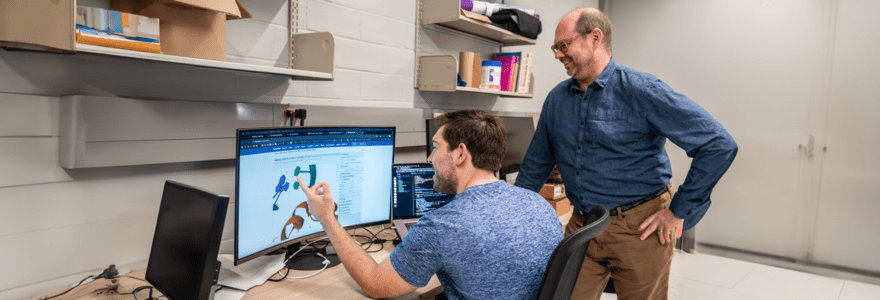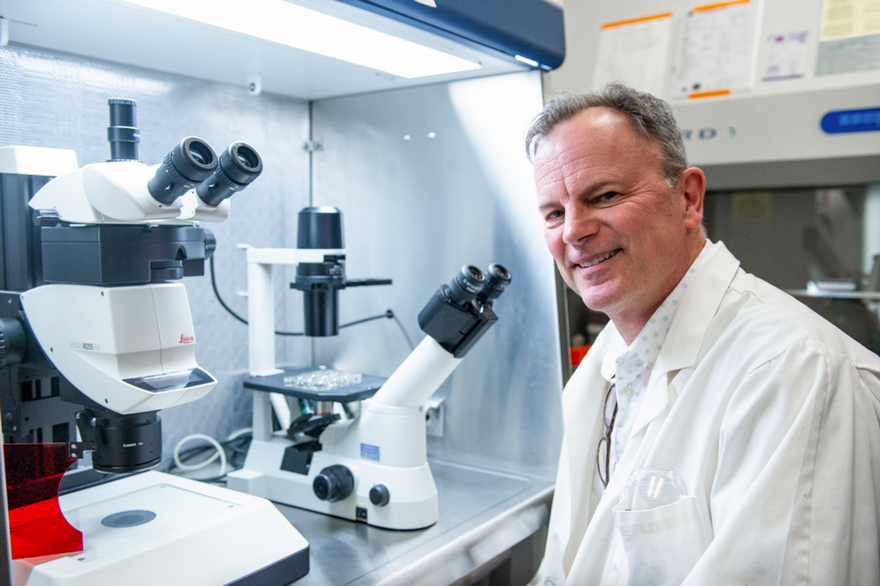Targeting toxic bacteria among research projects to receive CIHR project funding

By Cam Buchan
Schulich School of Medicine & Dentistry researchers are investigating new ways to control toxic bacteria, and exploring rapid and safe methods to improve in vitro fertilization rates.
These research projects are among several initiatives underway by Schulich Medicine & Dentistry researchers who - combined - received more than $2 million in funding from the Canadian Institutes of Health Research (CIHR) through its latest project grants competition.
David Edgell and a team of researchers are developing a more accurate way to kill the toxic bacteria that cause serious, often deadly, illnesses.
“Antibiotics work great in battling microbial infections, except that most of them target every bacterium in your body,” said Edgell. “They not only wipe out the toxic bacteria, but they also harm the good bacteria.”
Edgell, PhD, along with fellow researchers Greg Gloor, PhD, and Bogumil Karas, PhD, in the Department of Biochemistry, and David Heinrichs, PhD, in the Department of Microbiology and Immunology, will develop and test a new method of delivering a technology called CRISPR into specific individual toxic bacterial species to kill them. The work builds on papers published in Nature Communications in 2019 and 2023. The team received $937,125 over five years for the work.
CRISPR – an acronym for Clustered Regularly Interspaced Short Palindromic Repeats – is used naturally by bacteria to target and disable specific genes, including toxic gene sequences that contribute to antimicrobial resistance. A molecule called a guide RNA (gRNA) sends the CRISPR tool to the toxic gene sequence and cuts it like a pair of genetic scissors.
This tool will hopefully provide a new solution in solving the antimicrobial resistance problem, Edgell said.
“We’re developing an antimicrobial agent that specifically targets only the toxic bacteria we want to destroy and leaves the good ones alone,” said Edgell. “We hope it will result in less antibiotic resistance and a more effective treatment of the bacteria you’re actually going after.”
One bacterium in their sites is Enteropathogenic E. coli (EPEC) – an important cause of childhood diarrhea and contributor to the serious contamination of municipal water in Walkerton, Ontario.
“One of the problems with antibiotics is that we're running out of them and it’s getting harder to discover new ones with a mechanism of action we haven't over-used. This is an exciting alternative to traditional antibiotics.”
Identifying the most viable embryos for safer, more successful in vitro fertilization
Dean Betts, PhD, is investigating how to increase the success and safety of assisted reproductive technology (ART) and help ensure the health of mothers and their children utilizing this approach.
In vitro fertilization and other assisted methods account for approximately four per cent of children born in most developed countries. However, the success rate for ART is only one-third of all patients.
At the same time, a shift in clinical practice to single embryo transfer to reduce multiple pregnancies and the associated health complications has resulted in the need for a rapid, non-invasive method of assessing the most viable embryos for transfer.
Betts, professor in the Department of Physiology and Pharmacology, received $719,000 over five years to study small non-coding RNAs, called microRNAs, that are released by IVF embryos into the culture medium before implantation.
“By analyzing the specific patterns and levels of miRNA release, we aim to identify the patterns that make up successful pregnancies,” said Betts. “These studies are foundational for developing rapid and non-invasive methods to identify embryos with the highest developmental potential before embryo transfer.”
Betts said the ultimate goal is to improve the safety of mothers undergoing in vitro fertilization, as well as the health of their children who are conceived this way.
“The big benefit will be improving pregnancy and healthy live birth rates while reducing the financial and negative emotional cost of a failed pregnancy.”
Betts will be working with Dr. Abu Rafea, associate professor, Obstetrics & Gynaecology, Carlee Bates, lab director, Omega Fertility Center, Parisa Shooshtari, PhD, assistant professor, Pathology and Laboratory Medicine, Andrew Watson, PhD, professor, Physiology and Pharmacology, and Stephen Renaud, PhD, assistant professor, Anatomy and Cell Biology.

Congratulations to the other CIHR Project Grant recipients:
Sisira Sarma (Steven Habbous, Guangyong Zou, Kristin Clemens, Eric Nauenberg, Liisa Jaakkimainen, Scott McKay, Neville Suskin, Richard Kim, Nirav Mehta, Maria Mathews, Rose Anne Devlin, Bachir Belhadji, Amardeep Thind, Kelly Anderson, Saverio Stranges, Leigh Sowerby, Amit Garg)
Access to primary care services, preventive care, chronic disease management and patient outcomes in alternative primary care remuneration models.
Congratulations to the CIHR Priority Announcement recipients:
Stephen Barr
Hiding the enemy within: gaining new insights into HIV integration and the establishment and maintenance of latency.
Jennifer Guthrie (Idowu Olawoye, Jared Simpson, Finlay Maguire, Allison McGeer, George Golding, Kevin Katz, Madelyn Law)
Genomic Epidemiology of Methicillin‐Resistant Staphylococcus aureus Infections Prior to and During the COVID‐19 Pandemic
Patrick Lajoie, Rebecca Shapiro
A system approach to the regulation of the Candida albicans acetylome in drug resistance and pathogenicity
Kun Ping Lu, Elizabeth Gillies, Xiao Zhen Zhou, Jakob Magolan (David Litchfield, Brian Shilton)
Development of Optimized Reversible Pin1 Inhibitors to Block Multiple Cancer‐Driving Pathways and to Disrupt Immunosuppressive Tumor Microenvironment
Kun Ping Lu, Xiao Zhen Zhou, Douglas Fraser
Identification of Novel Disease Drivers, Therapeutic Targets, and Biomarkers of Sepsis
Piotr Wilk, Éric Lavigne (Anna Gunz, Rodrick Lim)
Trends and predictors of frequent and nonurgent use of emergency departments in Canada's paediatric population








